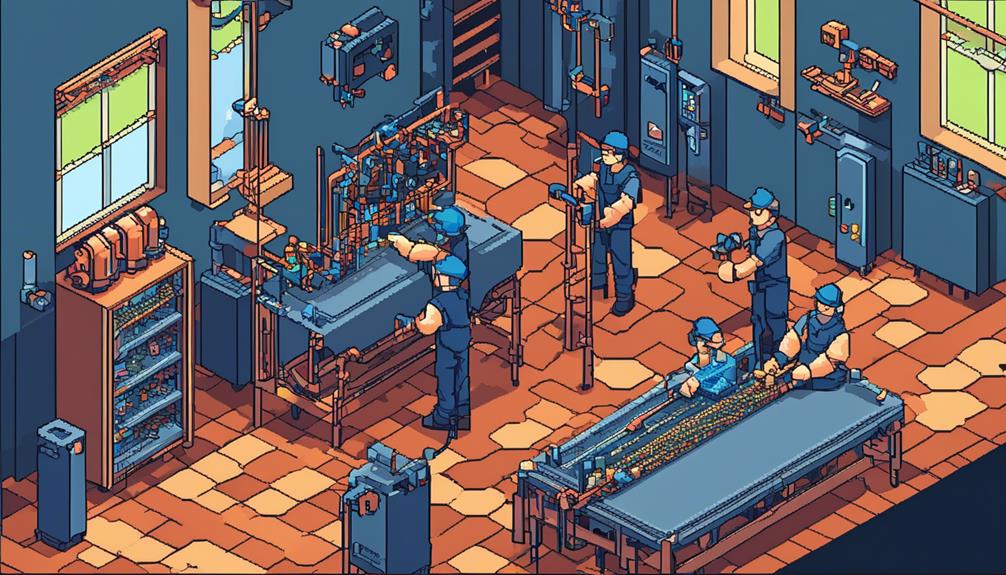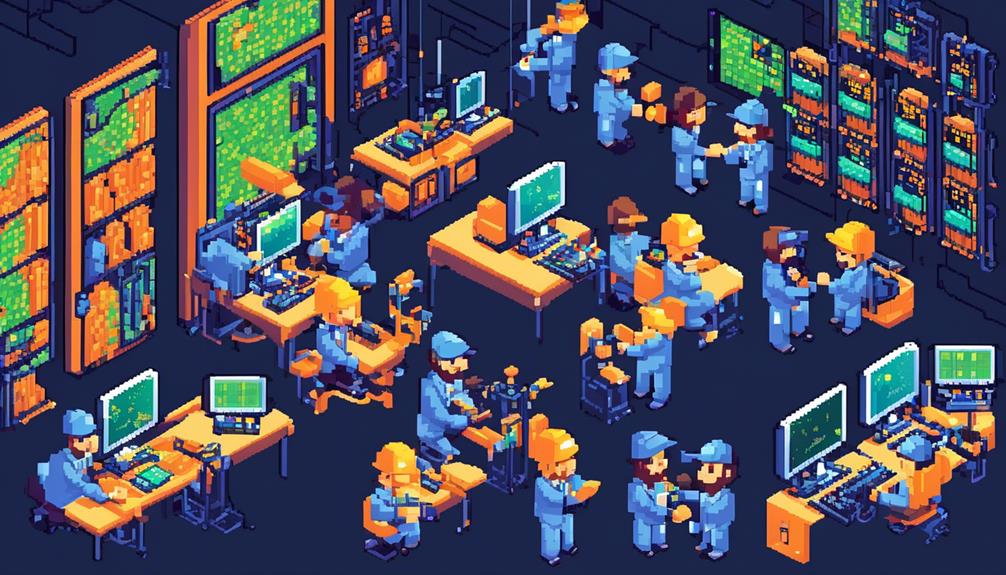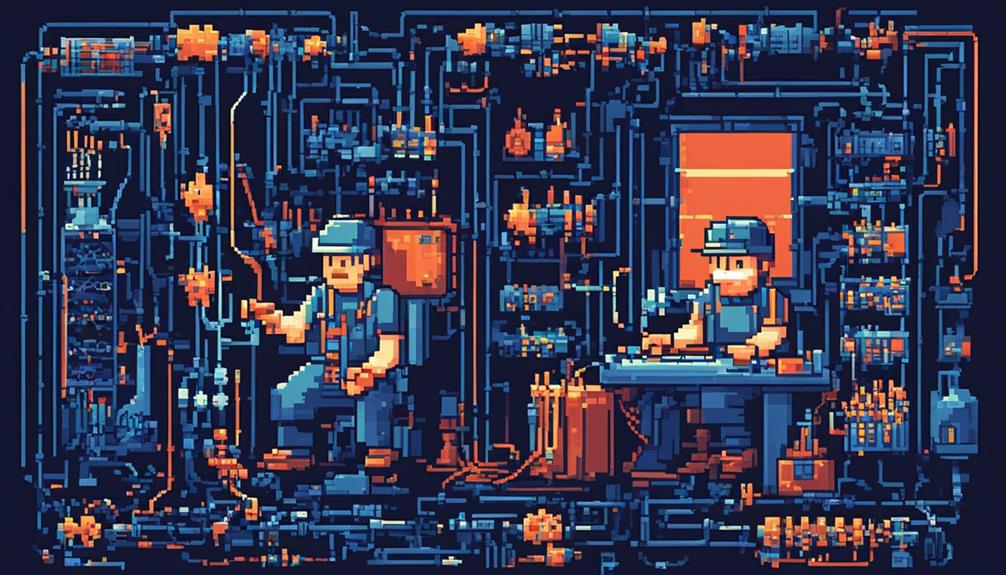In the ever-evolving world of telecommunications, maintaining the integrity of fiber optic networks is crucial to ensure uninterrupted connectivity. However, these networks are not exempt from occasional faults and damages that can disrupt communications and impact business operations.
When faced with such challenges, a systematic approach to repairing and restoring fiber optic networks becomes imperative. From assessing cable damage to implementing effective restoration techniques, this discussion will delve into the precise and technical aspects of repairing and restoring fiber optic networks.
By exploring topics such as emergency restoration planning, rapid fiber testing techniques, and the future trends in fiber optic restoration, we will uncover the intricate processes involved in ensuring network resilience and minimizing downtime.
So, let us embark on this journey of unraveling the intricate world of repairing and restoring fiber optic networks.
Key Takeaways
- Visual inspection and specialized tools like OTDRs, OPMs, and VFLs are essential for identifying and locating physical damage or faults in fiber optic cables.
- Emergency restoration planning involves implementing backup power solutions, network redundancy planning, and strategies for prompt restoration to minimize downtime.
- Rapid fiber testing techniques such as quick diagnostics, power level measurements, and the use of OTDRs and fiber microscopes can help detect and localize faults efficiently, reducing troubleshooting time.
- Backup power solutions and network redundancy planning are crucial for maintaining network connectivity during outages, with options like UPS systems, backup generators, energy storage solutions, and route diversity.
Fiber Optic Cable Damage Assessment

Fiber optic cable damage assessment involves the meticulous inspection and utilization of specialized tools to identify and locate physical faults or damage within the network.
Visual inspection is the first step in this process, allowing technicians to identify any visible physical damage or faults in the fiber optic cables. This may include cuts, breaks, or bends in the cables, as well as loose or damaged connectors.
To further assess the extent of the damage, specialized tools such as Optical Time Domain Reflectometers (OTDRs), Optical Power Meters (OPMs), and Visual Fault Locators (VFLs) are used. OTDRs emit a series of light pulses into the fiber optic cables and measure the time and intensity of the reflected signals, allowing technicians to pinpoint the location of any faults or breaks in the cables. OPMs, on the other hand, measure the power levels of the optical signals transmitted through the cables, helping to identify any loss of signal strength.
Once the damage has been identified and located, the next step is to repair or replace the damaged cables. This may involve splicing the cables together using fusion or mechanical techniques. Fusion splicing involves melting the ends of the fibers together, creating a permanent connection, while mechanical splicing utilizes connectors to join the fibers.
After the repair or replacement, the network needs to be tested and verified to ensure that the restoration process was successful. This can be done using tools such as OTDRs, OPMs, VFLs, or cable testers.
Emergency Restoration Planning
Emergency restoration planning is crucial for maintaining the reliability and uptime of fiber optic networks. Response time strategies should be developed to ensure a prompt and efficient restoration process in the event of network failures.
Backup power solutions, such as uninterruptible power supplies (UPS) or generators, should be implemented to mitigate power-related issues.
Additionally, network redundancy planning, including the use of redundant routes and spare fibers, can minimize downtime and provide alternative paths for data transmission.
Response Time Strategies
Implementing an efficient and well-structured restoration plan is crucial for minimizing downtime and swiftly restoring the functionality of fiber-optic networks in case of an outage. Here are some response time strategies to consider:
- Geographic diversity in network design: By incorporating multiple paths and connections, network failures can be isolated, allowing for continuous operation in the event of an emergency.
- Spare fibers and service loops: Having extra fibers available and storing additional cable in service loops facilitates quick restoration by providing readily accessible resources.
- Rapid fiber testing: Utilizing tools such as optical time domain reflectometers (OTDRs) and fiber microscopes enables swift and accurate diagnosis of cable conditions, reducing troubleshooting time.
- Efficient fault identification: Testing tools like visual fault locators (VFLs) and cleaning kits aid in the quick localization of faults, allowing for prompt repairs.
- Well-defined restoration plan: Having a detailed plan in place, which includes procedures for handling common issues like poor connector finishes and splices, streamlines the emergency restoration process.
Backup Power Solutions
Backup power solutions are a crucial component of emergency restoration planning in fiber optic networks. When a power outage occurs, it can disrupt the functionality of the network, leading to downtime and loss of connectivity. To address this problem, several backup power solutions can be implemented.
Uninterruptible power supply (UPS) systems are commonly used to provide temporary power during outages, ensuring continuous operation of equipment. Backup generators are another reliable source of power, particularly during prolonged outages, as they can sustain the network's power requirements. Energy storage solutions, such as batteries and capacitors, can also offer backup power for short-term outages.
Incorporating backup power solutions into the restoration strategy helps minimize downtime and maintain network connectivity. It is important to consider the power levels required by the equipment, the cable slack, connector finishes, and termination points to ensure a successful restoration process in fiber optic networks.
Network Redundancy Planning
To ensure continuous network operation in the event of failures or outages, network redundancy planning is crucial in fiber optic networks. Here are some key considerations for effective network redundancy planning:
- Route diversity: By analyzing service records and past failures, network operators can identify the most common types and locations of fiber-optic network failures. This information helps in creating route diversity, which involves designing alternate paths for the optical fiber to minimize the impact of localized failures.
- Spare fibers: Having spare fibers available for quick restoration is essential. These spare fibers can be used to quickly replace damaged ones, reducing downtime and ensuring uninterrupted service.
- Test equipment: Optical inspection microscopes, fiber-optic cleaning kits, and optical-loss test sets are crucial tools for network redundancy planning. They enable operators to identify and locate faults accurately, facilitating efficient restoration.
- Well-documented restoration plan: A well-documented restoration plan is essential for effective network redundancy planning. It outlines the steps and procedures to be followed in case of a cable break or other failures, ensuring a systematic and efficient restoration process.
- Fiber restoration: Network redundancy planning includes strategies for fiber restoration, such as fusion splicing or mechanical splicing, to repair damaged optical fibers. This ensures that the optical path is reestablished, allowing for the resumption of normal network operations.
Rapid Fiber Testing Techniques
Rapid fiber testing techniques play a crucial role in ensuring the quick and accurate diagnosis of cable conditions during emergency restoration. These techniques enable efficient fault detection and localization, reducing troubleshooting time and minimizing downtime.
Quick Fiber Diagnostics
Rapid fiber diagnostics play a crucial role in the restoration of fiber optic networks by enabling quick fault identification and localization, minimizing downtime and disruptions.
Here are five key techniques for conducting quick fiber diagnostics:
- Visual inspection: Performing a thorough visual inspection of fiber optic cables helps identify visible issues such as poor cable identification, damaged connector finishes, or physical damage.
- Power level measurements: Measuring power levels at various points along the optical path can help pinpoint faults caused by power loss or signal degradation.
- Fault locators: Using specialized fault locator tools can aid in quickly identifying breaks, bends, or other issues in the fiber optic cables.
- Cable testing: Conducting cable testing, such as continuity testing or reflectance testing, helps identify faults in the cable infrastructure.
- Accurate record-keeping: Maintaining accurate records of network configurations, test results, and previous repairs facilitates efficient troubleshooting and ensures timely restoration.
Efficient Fault Detection
Efficient fault detection in fiber optic networks requires the utilization of rapid fiber testing techniques to quickly and accurately diagnose cable conditions.
To achieve this, various tools and equipment are employed. Optical Time Domain Reflectometer (OTDR) is a key tool that measures the power and time characteristics of fiber optic cables. It provides valuable information about the location and severity of faults, enabling technicians to pinpoint the exact location of the problem.
Fiber microscopes and cleaning kits are used to inspect and clean connector finishes, as poor termination points can lead to signal loss and degradation.
Visual Fault Locators (VFLs) are also utilized to identify breaks or bends in the optical path.
By efficiently identifying and localizing faults, network downtime is minimized, ensuring seamless connectivity and productivity.
Regular testing and proactive maintenance are key components of an effective restoration strategy for fiber optic networks.
Fiber Optic Cleaning Methods

To maintain optimal network performance and minimize signal loss caused by contaminants, proper fiber optic cleaning methods are crucial. Cleaning fiber optic networks involves the use of specialized tools and cleaning kits to remove dust, dirt, and other contaminants from connectors and cables.
Here are some key fiber optic cleaning methods:
- Use optical inspection microscopes: These microscopes are used to identify poor connector finishes and surface contamination. By inspecting the connectors, technicians can detect any faults or defects that may affect the optical path.
- Clean connector end faces: Connector end faces can accumulate debris, which can lead to signal loss. Cleaning these end faces using lint-free wipes and solvents can help maintain a clean and reliable connection.
- Clean cable slack: Cable slack, especially in patch panels or cabinets, can gather dirt and dust. It is important to regularly clean and remove any accumulated contaminants to prevent signal degradation.
- Monitor power levels: Regularly monitoring power levels in fiber optic networks can help identify any changes or drops. If a temporary drop in power is detected, it may indicate the presence of contaminants that need to be cleaned.
- Clean temporary drop cables: Temporary drop cables are often used during network repairs or installations. These cables can accumulate contaminants, so it is important to clean them thoroughly before reconnecting them to the network.
Cable Repair and Restoration Techniques
During the process of cable repair and restoration, several tools and techniques are used to ensure that the fiber optic cables meet the required standards for optimum performance.
Optical inspection microscopes are utilized to identify poor connector finishes and surface contamination. By carefully examining the connector finishes, technicians can detect any imperfections or damage that may affect signal transmission.
Once poor connector finishes or surface contamination is identified, fiber-optic cleaning kits can be employed to resolve these issues. These kits contain specialized tools and cleaning solutions that effectively remove dirt, dust, and other contaminants from the connectors. Thoroughly cleaning the connectors ensures that the restoration process can proceed smoothly and the fiber optic cables are in optimal condition.
In addition to inspecting and cleaning the connectors, cable repair and restoration techniques also involve the use of optical-loss test sets. These test sets are used to perform end-to-end span tests and check power levels in the system. By measuring the loss of signal strength along the cable, technicians can identify any potential issues or faults that may require attention.
Visual tracers or fault locators are another valuable tool in the cable repair and restoration process. These devices transmit visible light through the fiber optic cables, allowing technicians to locate breaks or faults in the cable. By pinpointing the exact location of the issue, technicians can efficiently address the problem and restore the fiber optic network.
For more complex restoration scenarios, optical time-domain reflectometers (OTDR) are critical. Particularly in long-distance networks, OTDRs are used to analyze and troubleshoot cable issues. These devices emit light pulses into the fiber and measure the reflected signals, providing detailed information about the characteristics of the cable, such as distance to faults and attenuation. This information is invaluable in determining the best course of action for restoring the fiber optic network.
Rapid Response Fiber Splicing

Rapid Response Fiber Splicing is a critical process in the prompt restoration of fiber-optic networks during outages and failures. It plays a crucial role in minimizing downtime and ensuring seamless connectivity in fiber-optic networks.
Here are the key steps involved in this process:
- Prompt identification of the cable fault: When a fiber-optic network experiences an outage or failure, the first step in rapid response fiber splicing is to quickly identify the location of the cable fault. This is typically done using advanced equipment such as Optical Time Domain Reflectometers (OTDR) and visual fault locators.
- Creation of a repair point: Once the fault is identified, a repair point is created at the location of the fault. This involves carefully preparing the cable ends for splicing.
- Splicing the fiber: The next step is to splice the fiber at the repair point. This is done by carefully aligning and joining the fiber ends using fusion splicing or mechanical splicing techniques. Fusion splicing involves melting the fiber ends together, while mechanical splicing uses connectors to join the fibers.
- Testing the restored network: After the splicing is completed, the restored network is thoroughly tested to ensure proper functionality. This includes checking for any signal loss, verifying data transmission quality, and conducting end-to-end connectivity tests.
- Ensuring quality and reliability: Throughout the entire rapid response fiber splicing process, strict quality control measures are implemented to ensure the repaired network meets industry standards for performance and reliability.
Network Verification and Testing
Network verification and testing is a critical process in ensuring the proper functionality and performance of fiber-optic networks. It involves the use of various equipment such as optical inspection microscopes, fiber-optic cleaning kits, optical-loss test sets, visual tracers, and optical time-domain reflectometers (OTDR). These tools aid in verifying the integrity of the optical transmission and identifying any faults or issues that may be present in the network.
To effectively verify and test fiber networks, a systematic approach is necessary. This typically involves cable identification, physical plant inspection, fault identification, and performance testing. Cable identification ensures that the correct cables are being tested and verified, while physical plant inspection involves assessing the condition of the network infrastructure.
Fault identification is a crucial step in the process, as it helps pinpoint any problems or defects that may be affecting the network's performance. This can be done using OTDRs, which analyze the optical signal reflection and scattering to locate faults such as breaks or bends in the fiber.
Performance testing is essential to ensure that the network is functioning optimally. This can include measuring optical power levels, assessing signal quality, and checking for any transmission errors.
Ensuring Network Resilience

To ensure the resilience of fiber-optic networks, it is imperative to implement strategies such as route diversity and building restoration plans based on past maintenance records and repair records of failures. This ensures that the network is prepared for any potential disruptions and can quickly recover from them. Here are some key considerations for ensuring network resilience in fiber-optic networks:
- Implementing route diversity: By designing networks with multiple routes, operators can ensure that if one route fails, traffic can be rerouted through alternative paths. This helps to minimize the impact of network outages and ensures continuous connectivity.
- Building restoration plans: Having detailed restoration plans based on past maintenance and repair records is crucial. These plans outline the steps to be taken in the event of a failure, including the identification and repair of damaged fibers, splicing, and testing. This helps to streamline the restoration process and minimize downtime.
- Using advanced testing equipment: Optical inspection microscopes and OTDRs (Optical Time-Domain Reflectometers) are essential tools for identifying and resolving fiber-optic network failures. These devices allow technicians to accurately measure optical power, evaluate cable length in meters, assess connector finishes and surface conditions, and detect any faults or breaks in the fiber.
- Designing for redundancy: Building redundancy into the network infrastructure is another key aspect of ensuring network resilience. This includes creating backup options, duplicate links, and geographic diversity. Redundancy ensures that even if one part of the network fails, there are alternative paths available to maintain connectivity.
- Maintaining accurate records: Keeping accurate records of the physical plant, including fiber routes, splicing points, and network configurations, is essential for efficient network restoration. When a failure occurs, these records can be referenced to quickly identify the physical fiber and determine the best course of action for repair.
Future Trends in Fiber Optic Restoration
In the realm of fiber optic restoration, emerging trends are paving the way for advanced technologies and innovative approaches to automate fault detection and restoration processes.
One of these trends is the use of artificial intelligence and machine learning to identify faults in fiber optic networks without the need for an Optical Time Domain Reflectometer (OTDR). This technology can analyze real-time data from the network and pinpoint the location of the fault, eliminating the need for manual inspection and reducing restoration time.
Another trend in fiber optic restoration is the integration of self-healing capabilities within the network. This involves the use of intelligent algorithms that can automatically reroute traffic and restore the optical path when a fault is detected. By isolating the problem within the network and eliminating the need for human intervention, self-healing networks can significantly reduce downtime and improve network resilience.
Augmented reality (AR) and virtual reality (VR) solutions are also gaining traction in the field of fiber optic restoration. These technologies allow technicians to remotely troubleshoot and maintain networks, reducing the need for physical presence at restoration sites. Through AR and VR, technicians can visualize network components, identify faults, and perform repairs without being physically present, saving time and resources.
Predictive maintenance models are also emerging as a trend in fiber optic restoration. By analyzing data from the network and using predictive algorithms, potential failures can be identified proactively, enabling timely maintenance and preventing service disruptions. This approach helps to maximize network uptime and improve overall network performance.
Lastly, the adoption of robotics and drones for aerial inspections and repairs is becoming more prevalent. These technologies enable technicians to access difficult terrains and environments, where fiber optic cables are often deployed, without facing logistical challenges. Using robotics and drones for cable identification or lack thereof, adding closures or patches, and conducting repairs can significantly enhance the efficiency and effectiveness of restoration efforts.
Frequently Asked Questions
Can Fiber Optic Line Be Repaired?
Yes, fiber optic lines can be repaired using a variety of techniques and specialized equipment.
The restoration process involves identifying the fault location, repairing the damaged section, and testing the restored network for proper functionality.
Common causes of fiber optic line damage include cable damage, connector issues, and environmental factors.
It is important to follow best practices and avoid common mistakes when repairing fiber optic cables.
Regular maintenance and training for technicians are crucial, and advancements in technology continue to improve the repair process.
How Do You Restore Fiber?
Fiber restoration involves a series of techniques aimed at repairing and restoring fiber optic networks to their optimal functioning state. This process is essential to ensure uninterrupted communication and data transmission.
The importance of regular fiber maintenance cannot be overstated, as it helps identify and address potential issues before they escalate. Common causes of fiber damage include physical stress, environmental factors, and human error.
Diagnosing fiber optic issues entails thorough inspection, power measurements, and cable testing. Various tools such as OTDRs, fiber microscopes, and cleaning kits aid in the accurate diagnosis of problems. Fiber splicing methods are utilized for repairing damaged fibers.
Preventive measures, such as proper cable management and regular inspection, can minimize the risk of fiber damage. Fiber optic technicians play a crucial role in the restoration process, utilizing their expertise to identify, troubleshoot, and repair issues efficiently.
Restoring long-distance fiber networks presents unique challenges, including the need for specialized equipment and expertise. Weather conditions can also impact fiber restoration efforts, necessitating additional precautions and strategies.
What Should Be Done to Prepare for Fiber Optic Restorations?
To prepare for fiber optic restorations, several key steps must be taken. These include:
- Ensuring infrastructure is prepared with redundancy and backup options.
- Maintaining and regularly inspecting restoration equipment.
- Implementing emergency response protocols.
- Conducting quality assurance checks.
- Establishing thorough documentation management practices.
- Providing staff training in restoration procedures.
- Collaborating with service providers.
- Developing disaster recovery plans.
Additionally, testing procedures using tools such as OTDRs and visual fault locators should be employed to quickly identify and localize faults, minimizing downtime and ensuring seamless connectivity.
How Much Does It Cost to Repair a Broken Fiber Optic Line?
The cost to repair a broken fiber optic line can vary depending on a variety of factors. These factors include:
- The location and extent of the damage
- Accessibility to the damaged area
- The need for specialized equipment and expertise
- The length of the fiber optic line
Additionally, emergency repairs may incur higher costs due to the need for immediate response and potential overtime for technicians.
It is important to obtain quotes from reputable fiber optic repair companies and consider the long-term reliability and warranty of the repair work before making a decision.
